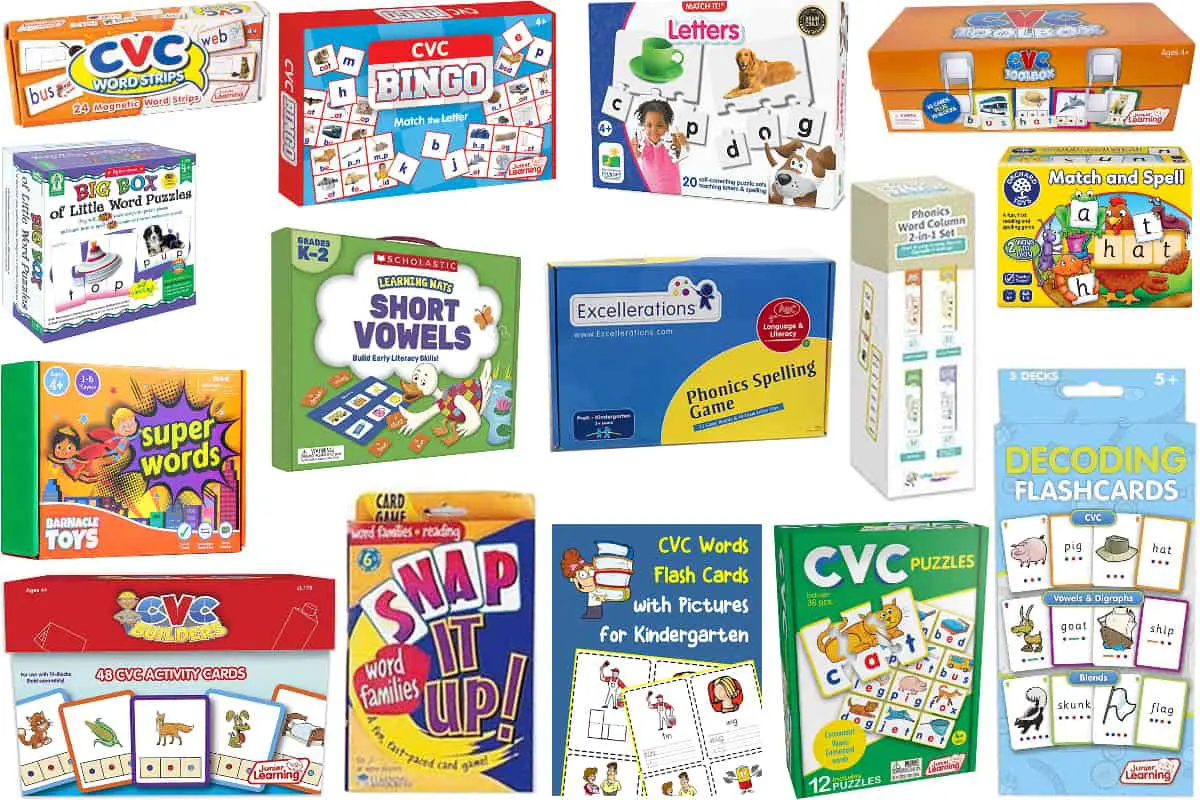This post contains affiliate links.
Using card games and flashcards to learn how to read and spell makes it more fun and less frustrating. And I have found 20 CVC card games and flashcards that you can try out.
The CVC card games and flashcards in this list teach phonemic awareness, phonics, spelling, and reading to 4–8-year-old beginning to emergent readers. Some of them can be played alone, while others require adult supervision.
CVC Card Games and Flash Cards Comparison Table
| Game | Age | Players | Rating |
|---|---|---|---|
| CVC Builders Activity Cards | 4-6 | 1+ | ★★★★☆ |
| CVC Toolbox | 4-6 | 1+ | ★★★★☆ |
| CVC Word Strips | 4-6 | 1+ | ★★☆☆☆ |
| Simple Words Spelling Game | 4-6 | 1+ | ★★★★☆ |
| Snap It Up! | 5-7 | 2+ | ★★★★☆ |
| CVC Puzzles | 4-6 | 1+ | ★★★☆☆ |
| Zingo Word Builder | 4-6 | 2-6 | ★★★★★ |
| Match It! Letters | 4-8 | 1+ | ★★☆☆☆ |
| Super Words | 4-6 | 1-6 | ★★★★★ |
| Word Shark: Short Vowels Game | 4-6 | 1-10 | ★★★★★ |
| Learning Mats: Short Vowels | 4-7 | 1+ | ★★★★☆ |
| Phonics Spelling Game | 4-6 | 1+ | ★★★★☆ |
| Match & Spell Puzzles | 4-6 | 1-4 | ★★★★☆ |
| CVC Bingo | 4-6 | 2-4 | ★★★★☆ |
| Big Box of Little Word Puzzles | 4-6 | 1+ | ★★★★★ |
| CVC SuperDeck Card Game | 4-6 | 1+ | ★★★★★ |
| CVC Words Fluency SuperDeck Card Game | 5-7 | 1+ | ★★★★★ |
| Phonics Flash Cards | 4-8 | 1+ | ★★★★★ |
| Decoding Flashcards | 4-8 | 1+ | ★★★★☆ |
| CVC Words Flash Cards | 4-6 | 1+ | ★★★☆☆ |
CVC Card Games
CVC Builders Activity Cards (Junior Learning)
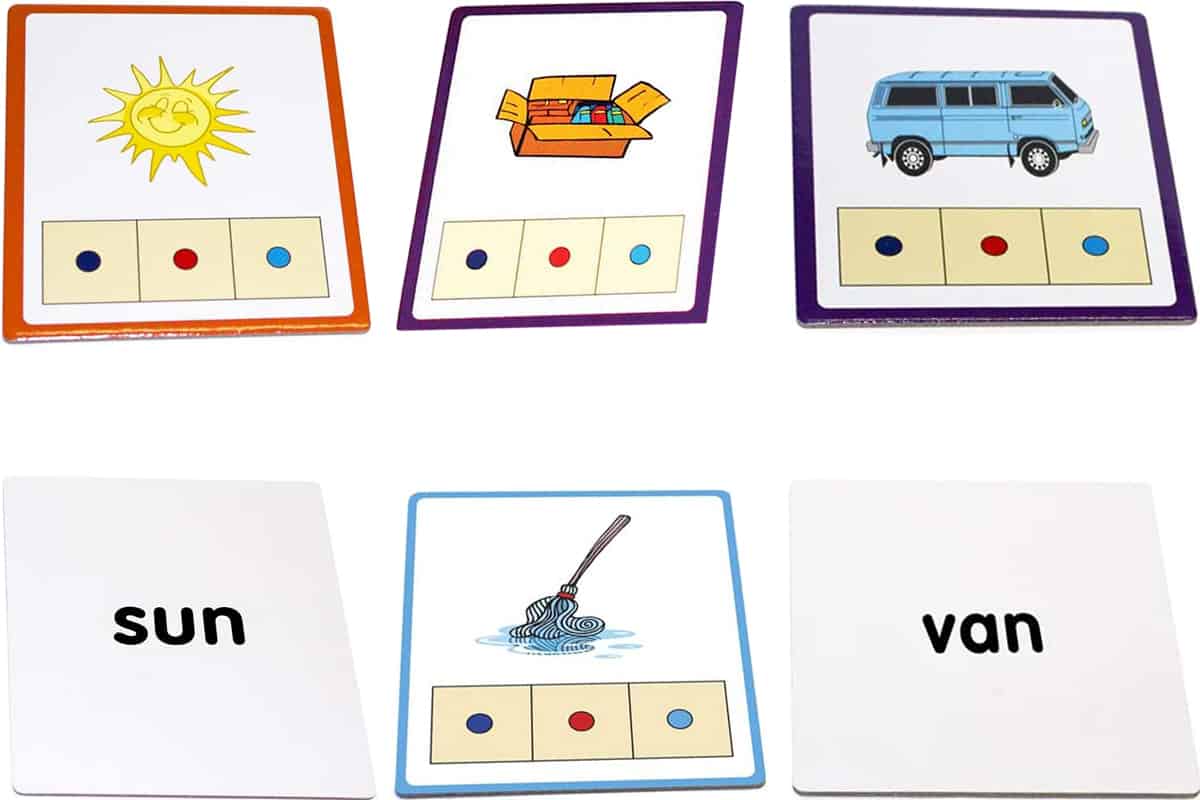
★★★★☆
For Families and Schools | Age 4-6 | 1+ players | Price $$ | Duration 10-20 min
CVC Builders Activity Cards help your child develop their phonological awareness. It features 48 activity cards with phoneme color coding and the whole word on the backside.
help your child develop their phonological awareness. It features 48 activity cards with phoneme color coding and the whole word on the backside.
The cards are also color-coded by difficulty. So, adults can quickly identify which set they can use, depending on their child’s ability. I like this set because:
- The color-coded phoneme parts help struggling students with identifying beginning, middle, and ending sounds
- There is no letter on the boxes, so beginning readers can focus on the sounds only and not phonics.
- Pictures help build image-word associations for younger children.
- You can use them to teach phonics and spelling
- It has the words at the back for self-correction
If you want to also use these cards to teach CVC spelling, you may also get this set of CVC blocks from Junior Learning and let them build the words.
CVC Toolbox (Junior Learning)
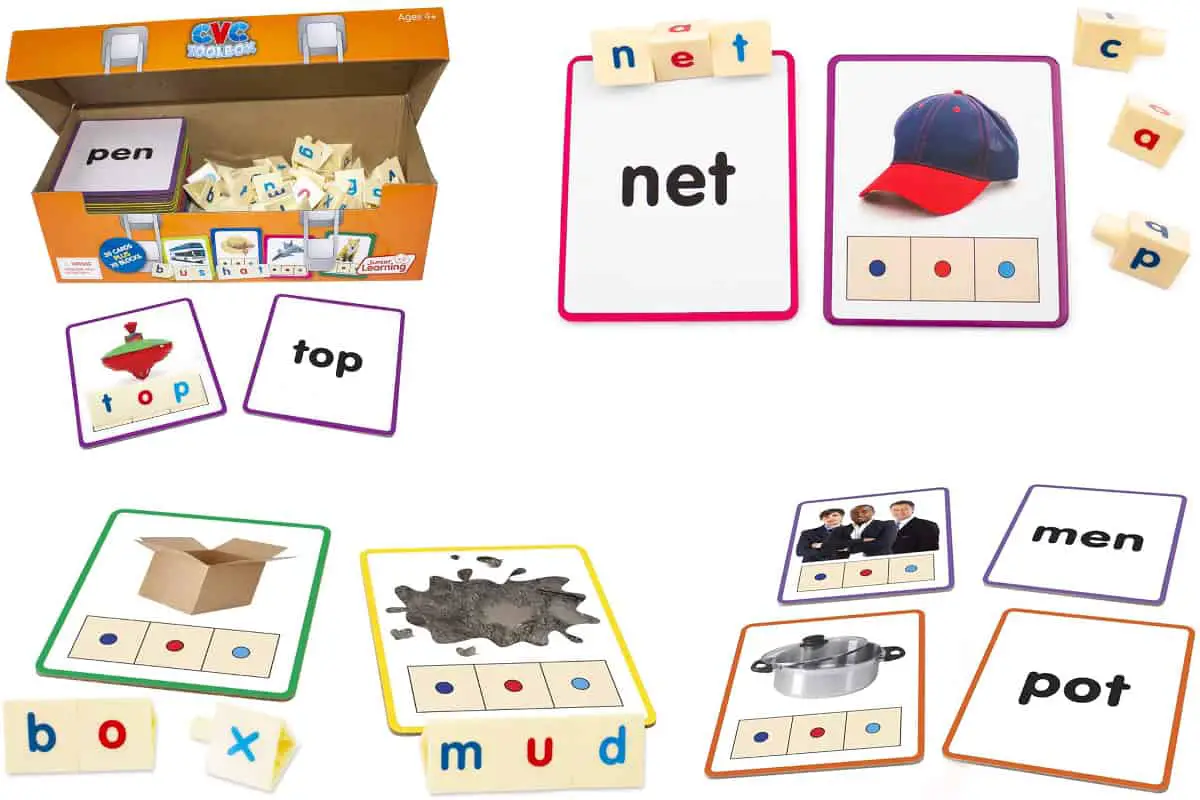
★★★★☆
For Families and Schools | Age 4-6 | 1+ players | Price $$$ | Duration 10-20 min
The CVC Toolbox is similar to the game above, except it already comes with CVC blocks. It also comes with five more cards, so it has 30 words cards and real photography images.
is similar to the game above, except it already comes with CVC blocks. It also comes with five more cards, so it has 30 words cards and real photography images.
I like this game because:
- It can help you teach your child phonemic awareness, phonics, blending, and spelling.
- You can also use it to practice reading fluency with beginning readers
- it already includes the CVC blocks, which allow children to develop better letter-sound correspondence and engage them in learning
- the manipulatives are color-coded: blue for beginning sounds, red for middle sounds, and light blue for ending sounds
- the words are at the back of the card for independent learning
But I give this game only four stars because the cards are not color-coded based on difficulty, unlike the CVC Builders Activity Cards. Also, the letters do not allow much variation as they are made specifically for the words in this set. For example, if your child needs to spell cab, they will not find any end -b to attach to c and a.
CVC Word Strips (Junior Learning)

★★☆☆☆
For Families | Age 4-6 | 1+ players | Price $$$ | Duration 10-20 min
CVC Word Strips feature 24 magnetic word strips to help your child practice their phonics. The cards also have photographic images of the words.
feature 24 magnetic word strips to help your child practice their phonics. The cards also have photographic images of the words.
This set is easy to use. But you need to buy the Rainbow Letters magnetic set to be able to use it. I like this game because:
to be able to use it. I like this game because:
- it is double-sided, with the printed word on the other side for self-correcting learning
- the cards have a real-life picture of the objects
- it is reusable and great for students who cannot write yet
I give this game two stars only because the magnetic letters do not come with the set yet. And without them, the word strips are not as useful for teaching spelling. But you can still use them to teach blending CVC words.
Simple Words Spelling Game (Gamenote)
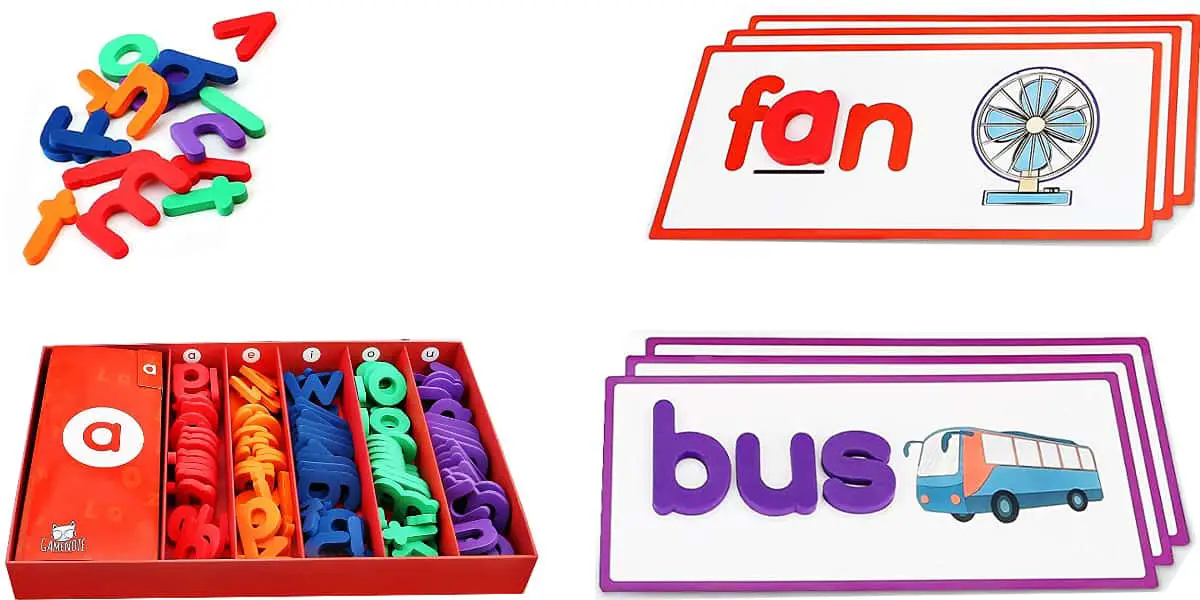
★★★★☆
For Families and Schools | Age 4-6 | 1+ players | Price $$ | Duration 10-20 min
Gamenote’s Simple Words Spelling Game is an excellent tool for teaching CVC reading and spelling. This set features 50 words cards – 10 per vowel and 150 easy-grip foam letters.
is an excellent tool for teaching CVC reading and spelling. This set features 50 words cards – 10 per vowel and 150 easy-grip foam letters.
The cards and letters in this set are color-coded by their middle sounds, and the game comes with a box with separators for these letters. I highly recommend this game because:
- it comes with over 150 letters, so it is perfect for use in schools
- you can use it to teach phoneme isolation since the other side of the cards have missing letters
- the box comes with labeled partitions for easy sorting during cleanup
- the letters can also be used without the cards to practice spelling other CVC words and to learn the alphabet
The only problem with this game is the letter’s durability. While the letters are perfect for small hands, they are also easy to break because they are foam.
Snap It Up! (Learning Resources)
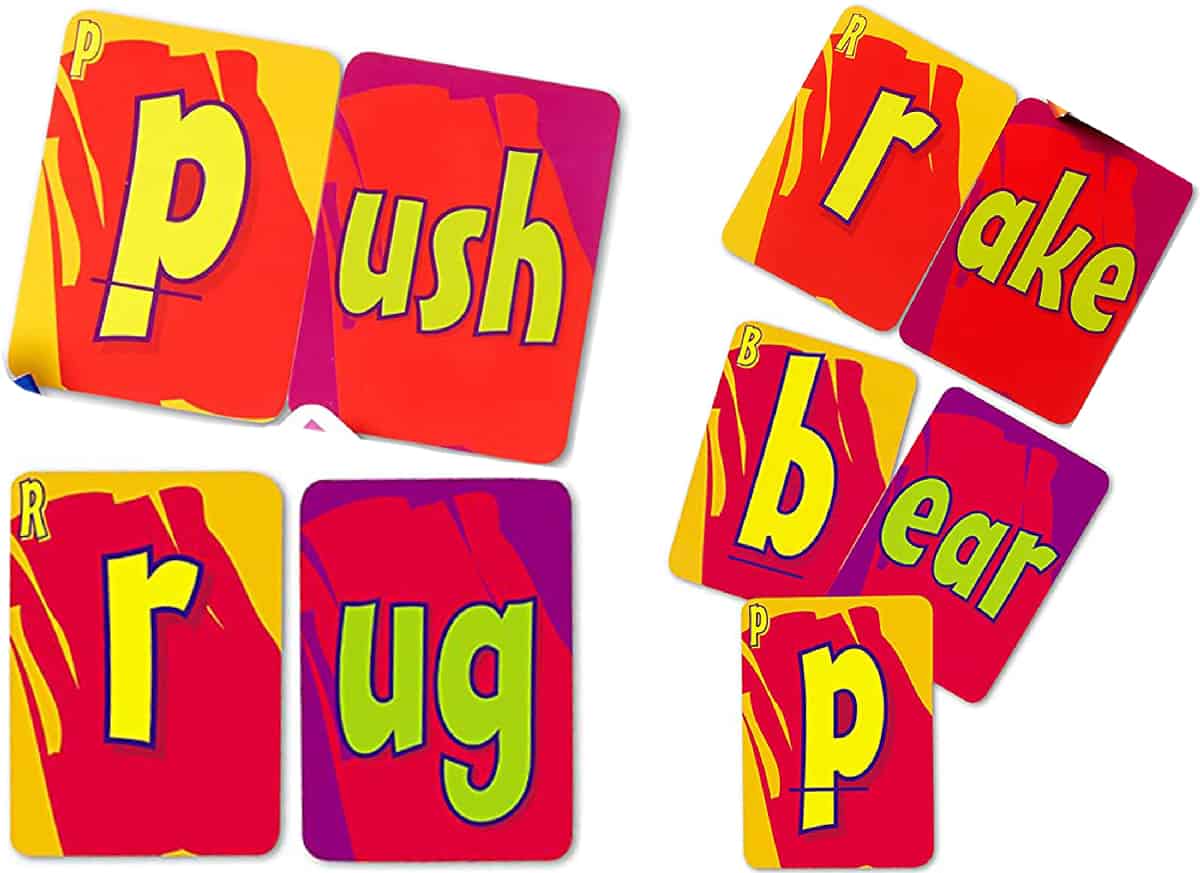
★★★★☆
For Families and Schools | Age 5-7 | 2+ players | Price $$ | Duration 10-20 min
Snap It Up! is a fun, fast-paced game that you can use to teach word families and blending. It has a total of 90 cards with 26 word-family cards and 64 consonant cards.
To play the game:
- deal out all the consonant cards, then the players keep three on hand and leave the rest as their personal draw deck
- one player flips the first-word family card, and players simultaneously try to match a consonant on their hand to it
- the first player to make a real word match needs to yell “snap.”
- another word family card is flipped, then when a person gets a second match, they yell “it,” and for the third match, say “up.”
The first player to get three matches wins the game. Children may have to play several times before fully understanding the instructions, especially if they are only starting to read. This game is also best played with children with the same reading proficiency. It is a fast-paced game, so struggling readers may tend to always lose against more advanced readers.
I like this game because it reinforces both spelling and reading skills. But it must be noted that it also has four long vowel pattern cards included in the 26 word families. And you may need to remove them if the players are not confident readers yet. Or, for more fluent beginning readers, keep these long vowel cards in the deck for an extra challenge.
CVC Puzzles (Junior Learning)
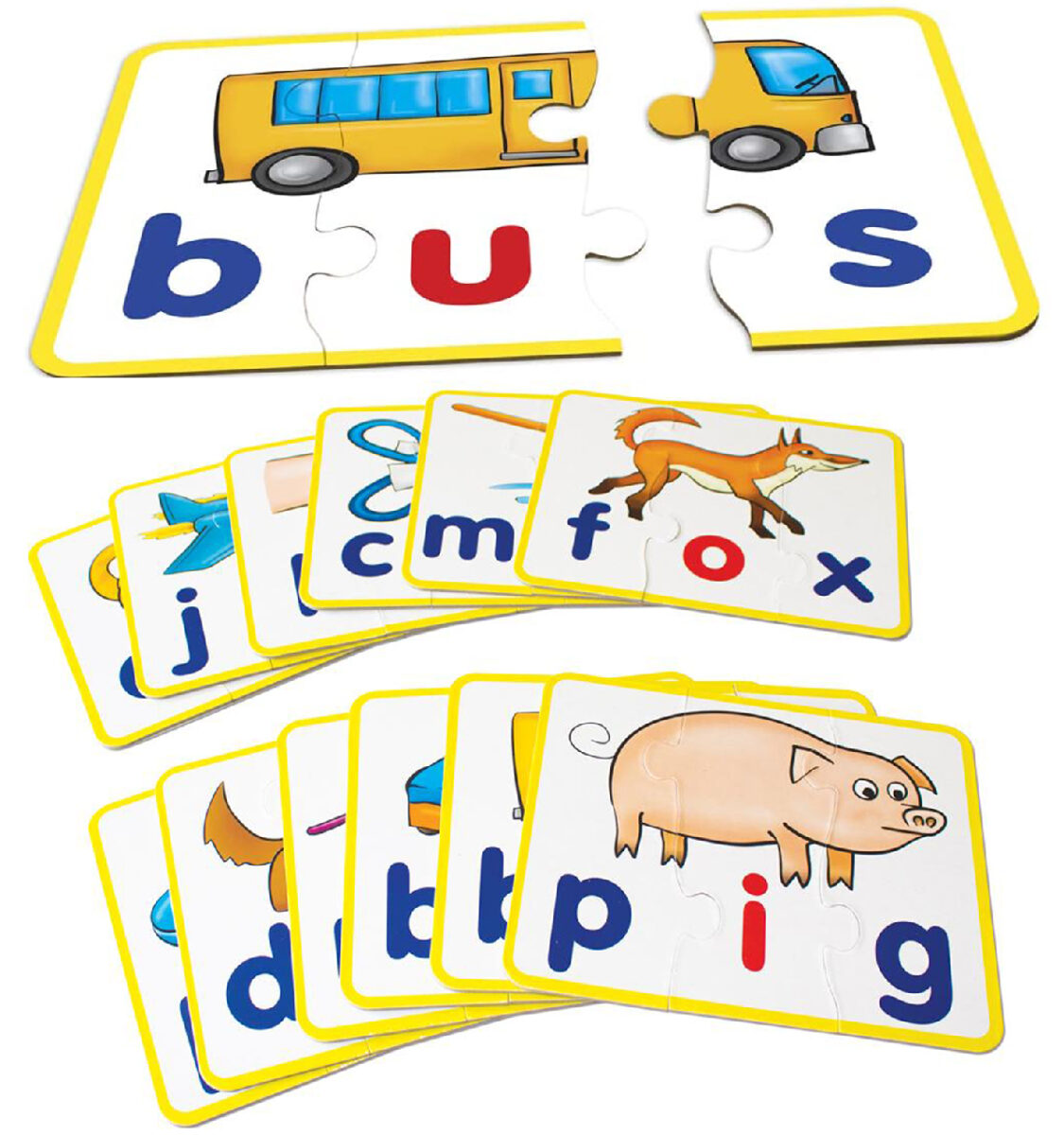
★★★☆☆
For Families | Age 4-6 | 1+ players | Price $$ | Duration 10-20 min
Junior Learning’s CVC puzzles come with 12 CVC words and 36 puzzle pieces. Each puzzle features colored images of the objects.
come with 12 CVC words and 36 puzzle pieces. Each puzzle features colored images of the objects.
I like this set because:
- letters are color-coded – blue for consonants and red for vowels, which reinforces this distinction
- images allow self-correcting and independent play
- it is a fun way to teach blending and spelling
However, I give this game three stars only because there are only 12 words in the set, and most of them are short /a/ words. The cards are also thin – similar to UNO cards and not ideal for classroom learning or younger children.
Zingo Word Builder (ThinkFun)
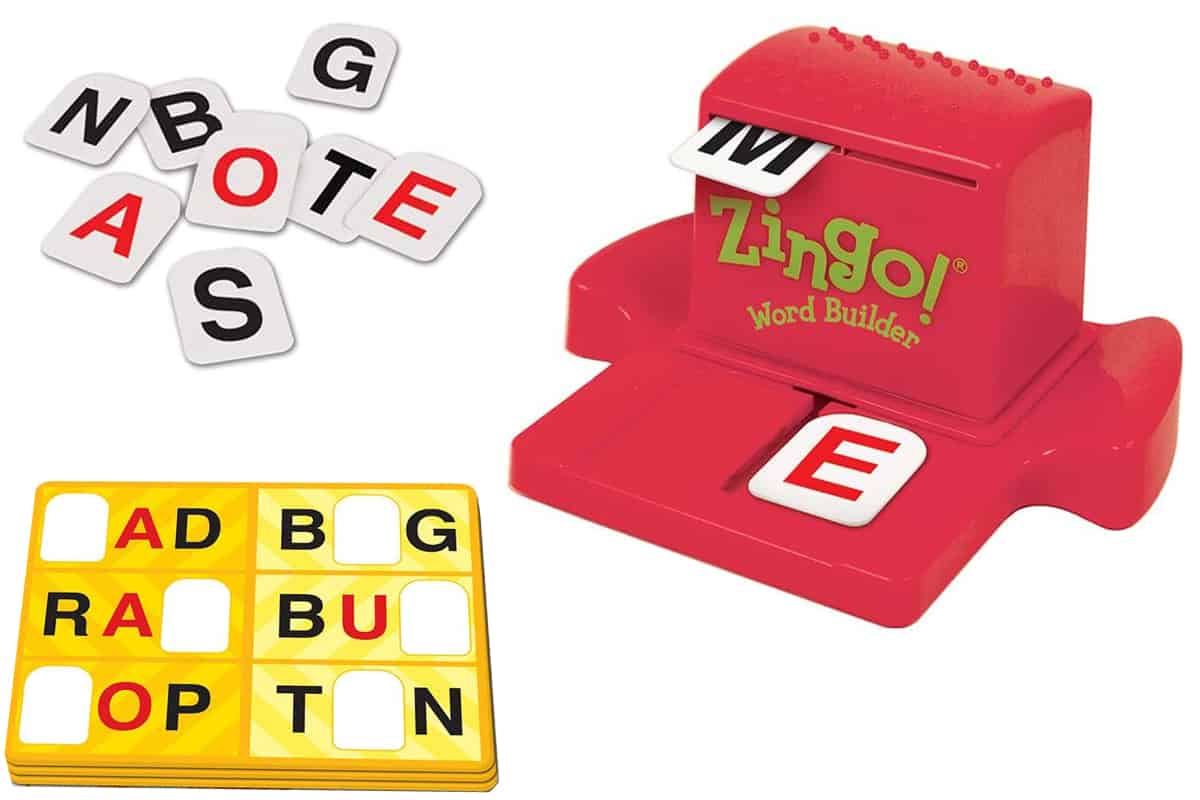
★★★★★
For Families and Schools | Age 4-6 | 2-6 players | Price $$ | Duration 20-30 min
Zingo World Builder is a bingo-inspired CVC card game for beginning readers. It features 6 double-sided cards and 72 double-sided tiles.
is a bingo-inspired CVC card game for beginning readers. It features 6 double-sided cards and 72 double-sided tiles.
This game is simple. Players only need to:
- Slide the Zinger.
- Use the letters to build a word.
- Fill all the missing blanks in your card first to win.
I like this game because the instructions are easy to follow for young players. In addition, Zingo World Builder:
- incorporates fun with motor skills development as kids need to press and fill the Zinger during play
- reinforces phonemic awareness and enhances vocabulary
- is quick to play – making it perfect for schools and homes
There are six words on each side of the card, so there are 72 words in total. Missing letters vary, so there is always a challenge to make a different word for every turn. Therefore, this game has high replayability. The only challenge is that an adult may need to be present to make sure that the children make real words. Or challenge your beginning readers to make nonsense words and read them!
Match It! (The Learning Journey)

★★☆☆☆
For Families | Age 4-8 | 1+ players | Price $$ | Duration 10-20 min
Match It! is a puzzle card game that teaches early reading skills like letter recognition and spelling. Each set comes with 20 puzzle sets.
is a puzzle card game that teaches early reading skills like letter recognition and spelling. Each set comes with 20 puzzle sets.
Players only need to match the letters to the picture to complete the puzzle. So it is an easy and enjoyable game for beginning readers. I like this game because:
- the pieces only fit if it’s the correct sequence, so it is excellent for self-correction
- it helps develop fine motor skills and problem-solving skills
- the puzzle pieces are made of durable material
However, I can only give this game two stars because not all the words in the set are CVCs. There are sight words like bee and cow that is a four-year-old player may not know how to spell yet. So, this game is not a great introduction to spelling if your child is only starting to read. Another problem is the number of words included in the set. There are only 20, and children may easily tire of these pieces after they have memorized them.
Super Words (Barnacle Toys)

★★★★★
For Families and Schools | Age 4-6 | 1-6 players | Price $$ | Duration 20-30 min
Super Words is a matching and sorting card game that teaches CVC word families. Each box includes 22 words families, 11 game boards, and 132 game pieces.
is a matching and sorting card game that teaches CVC word families. Each box includes 22 words families, 11 game boards, and 132 game pieces.
This game is super easy to play. Your child needs to find the CVC word that matches the picture on the board. I like this game because:
- it develops analytical thinking skills as children sort and match the CVC words to their families
- it teaches rhyming and word recognition
- it also lets your child practice their reading skills
- it expands your child’s vocabulary
To challenge your child further, let them think of more words for each word family.
It is advisable to sort the CVC word cards into smaller groups before play. There are 132 game pieces, and children may find it confusing and frustrating to go through all of them. Breaking it into smaller groups also allows more students to play with this game. Some pictures may also be unfamiliar for the players, so minimal adult supervision is needed during play.
Word Shark: Short Vowels Game (Teacher Created Resources)

★★★★★
For Families and Schools | Age 4-6 | 1-10 players | Price $$ | Duration 10-30 min
Word Shark: Short Vowels Game is a two-in-one game that teaches CVC reading and spelling. It features 10 double-sided mats, 58 vowel tiles, and 92 consonant tiles. There are also two cards assigned for each vowel.
is a two-in-one game that teaches CVC reading and spelling. It features 10 double-sided mats, 58 vowel tiles, and 92 consonant tiles. There are also two cards assigned for each vowel.
There are several ways to play this game. To play the shark side of the mat:
- each player gets their own mat
- They take turns drawing a tile and trying to find a working chunk to add it to.
- If there’s a match, they keep the tile; otherwise, return the tile to the draw pile
- The first player to complete their mat wins
On the other side – the blank mat- players may opt for a crossword or Scrabble-like play. You can also use it for spelling contests!
I like this game because:
- It lets up to 10 players play the game at the same time
- It develops phonemic awareness and phonics
- It teaches reading and critical thinking skills
- The blank side is highly customizable to fit your child’s needs
This game supports different skill levels, so it can be played with varying levels of beginning readers at home and school!
Learning Mats: Short Vowels (Scholastic)
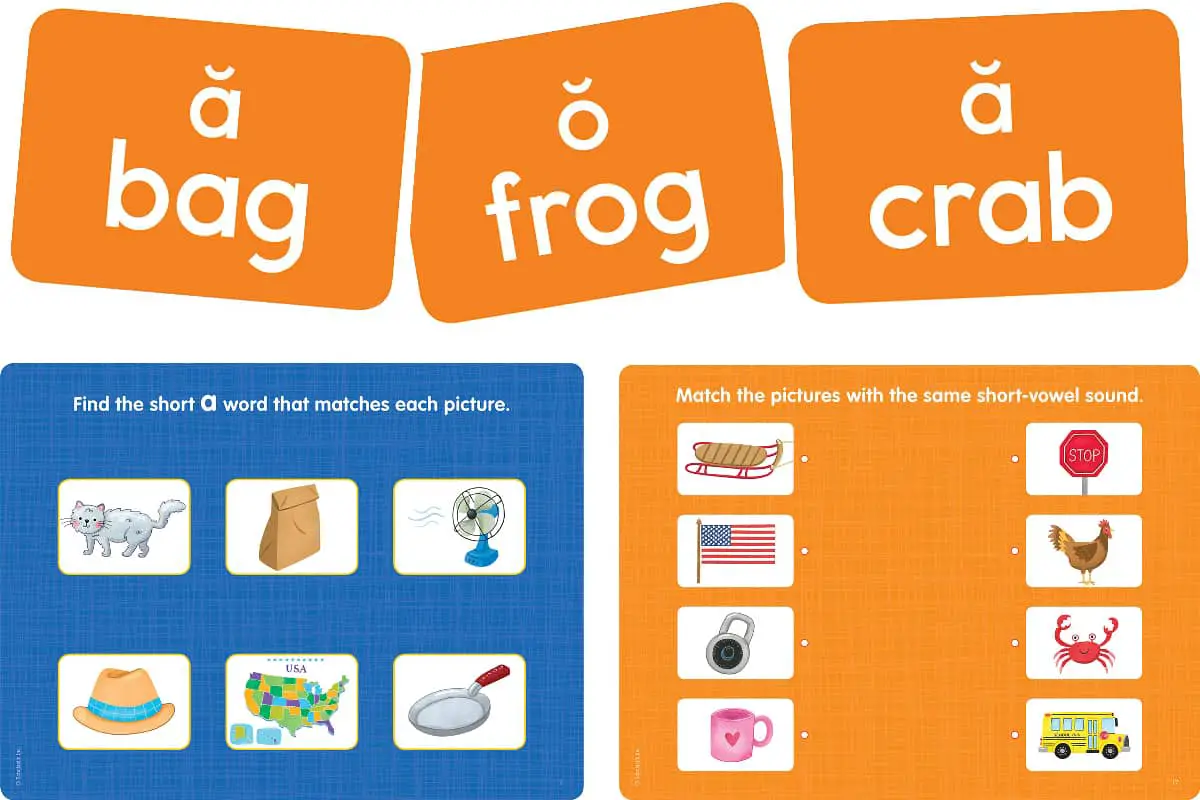
★★★★☆
For Families and Schools | Age 4-7 | 1+ players | Price $$ | Duration 10-20 min
Learning Mats: Short Vowels is a set of multiple games aimed at teaching students reading and spelling. Each box comes with 10 double-sided mats, 60 word tiles, 4 blank tiles, and a wipe-off marker.
is a set of multiple games aimed at teaching students reading and spelling. Each box comes with 10 double-sided mats, 60 word tiles, 4 blank tiles, and a wipe-off marker.
I like this set because it helps teach reading and spelling using different methods, like:
- Rewriting CVC words
- Matching word cards to pictures
- Matching pictures with the same word vowel sound
It also expands your child’s vocabulary and helps them develop their fine motor skills. However, some of the words here already incorporate beginning blends. So, you may need to remove them or help your child read them when playing.
Phonics Spelling Game (Excellerations)
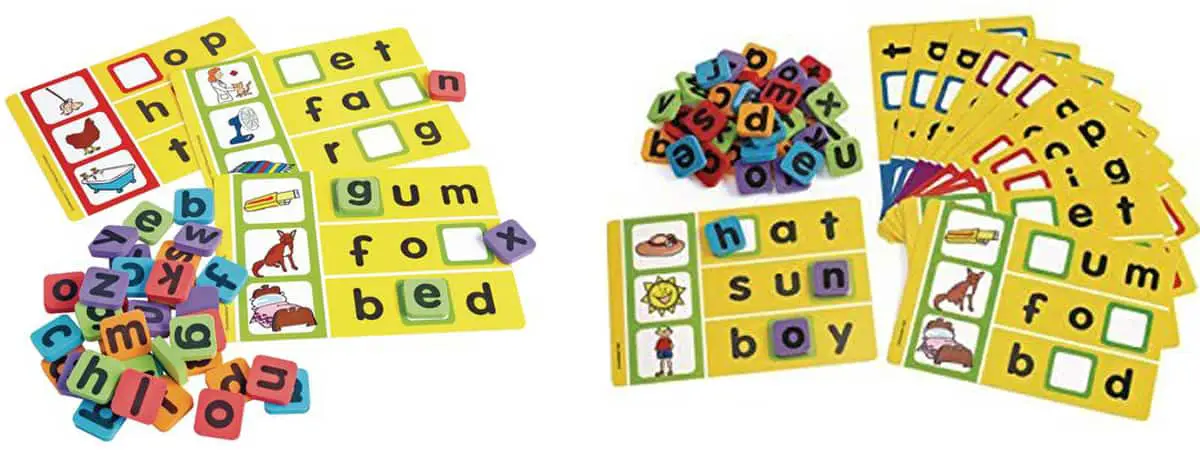
★★★★☆
For Families and Schools | Age 4-6 | 1+ players | Price $$$ | Duration 10-20 min
Phonics Spelling Game is a fill-in-the-blank card game for teaching phoneme isolation and spelling. Each set features 12 game boards and 40 durable foam letters.
is a fill-in-the-blank card game for teaching phoneme isolation and spelling. Each set features 12 game boards and 40 durable foam letters.
This game is easy to play. Your child can play competitively and race against other players, or they can play on their own with minimal guidance. I like this game because it helps beginning readers:
- Understand that words are made up of phonemes
- Identify beginning, middle, or ending sounds in a word
- Develop spelling skills
There are pictures in the cards to help your child identify the words and missing phonemes. But children may need supervision during play because some of the words are not CVCs.
I rate this game four stars because of the durability of the foam letters. However, they are prone to breaking, especially if used in classrooms and by younger children.
Match & Spell Puzzles (Orchard Toys)
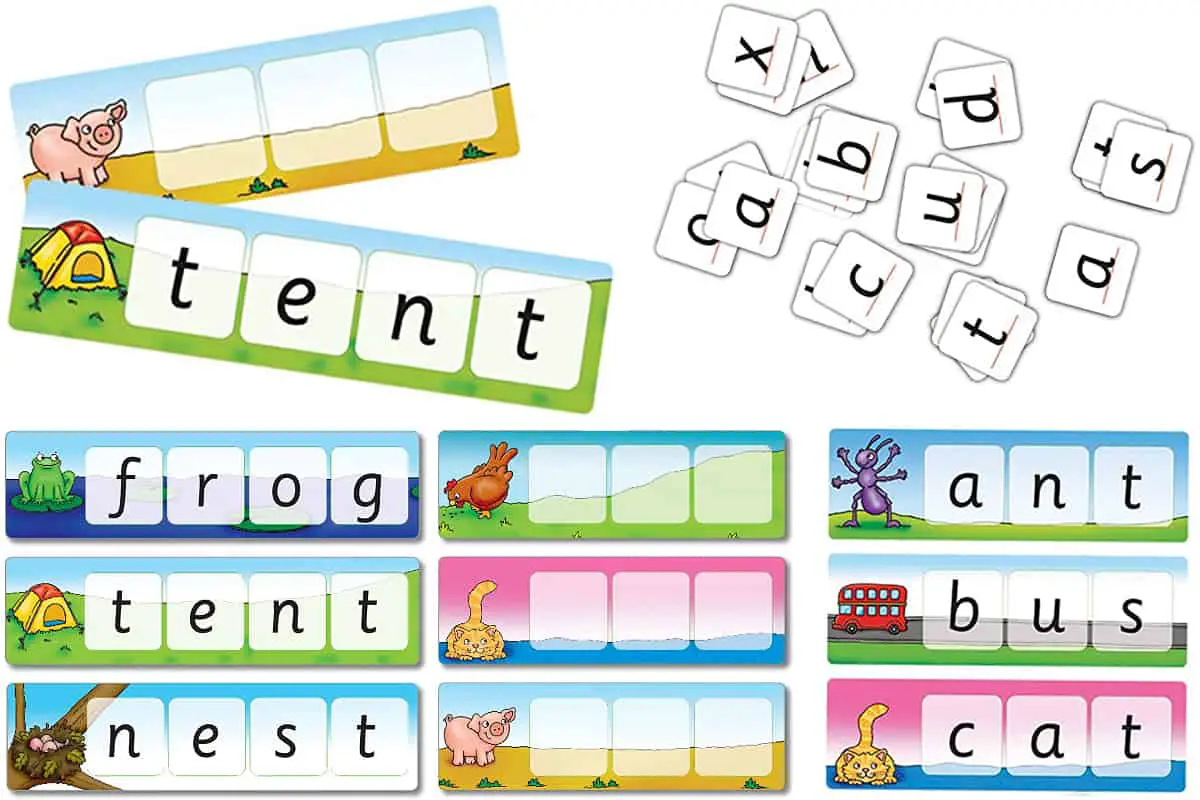
★★★★☆
For Families and Schools | Age 4-6 | 1-4 players | Price $$$ | Duration 10-20 min
Match & Spell Puzzles is a matching and spelling card game for beginning readers. Each set contains 12 double-sided 3-letter cards, 8 double-sided 4-letter word cards, and 68 letters.
is a matching and spelling card game for beginning readers. Each set contains 12 double-sided 3-letter cards, 8 double-sided 4-letter word cards, and 68 letters.
You can play in two ways. First, you can use the side with the words to reinforce alphabet and print knowledge. This side can also be used to teach blending. Then, use the blank side to teach spelling. You may also opt to let your child play these two ways in one game. To do this:
- Distribute the cards to the players
- With the word side up, let the children find the letters to build the words. Encourage them to sound the letters out before putting them on the cards. Let them do this until they complete all their cards.
- Then, ask them to scatter all their letters in front of them. Then, use the blank side.
- Players have to sound out the word to find the letters needed to spell them.
- After spelling the word correctly, read it out loud. Then, proceed to another card.
You can use this for competitive playing, where players need to race to complete their cards first. Or make it a cooperative play and let the children help each other finish their cards. Your child can also play this on their own and use the word side for self-correcting.
I like this game because it has two difficulty levels, making it great for teaching children with different reading levels. It also has some cards that introduce blends which is good for more advanced beginning readers.
However, this game does not have all the letters of the alphabet. It only has those that are needed for each card.
CVC Bingo (Junior Learning)
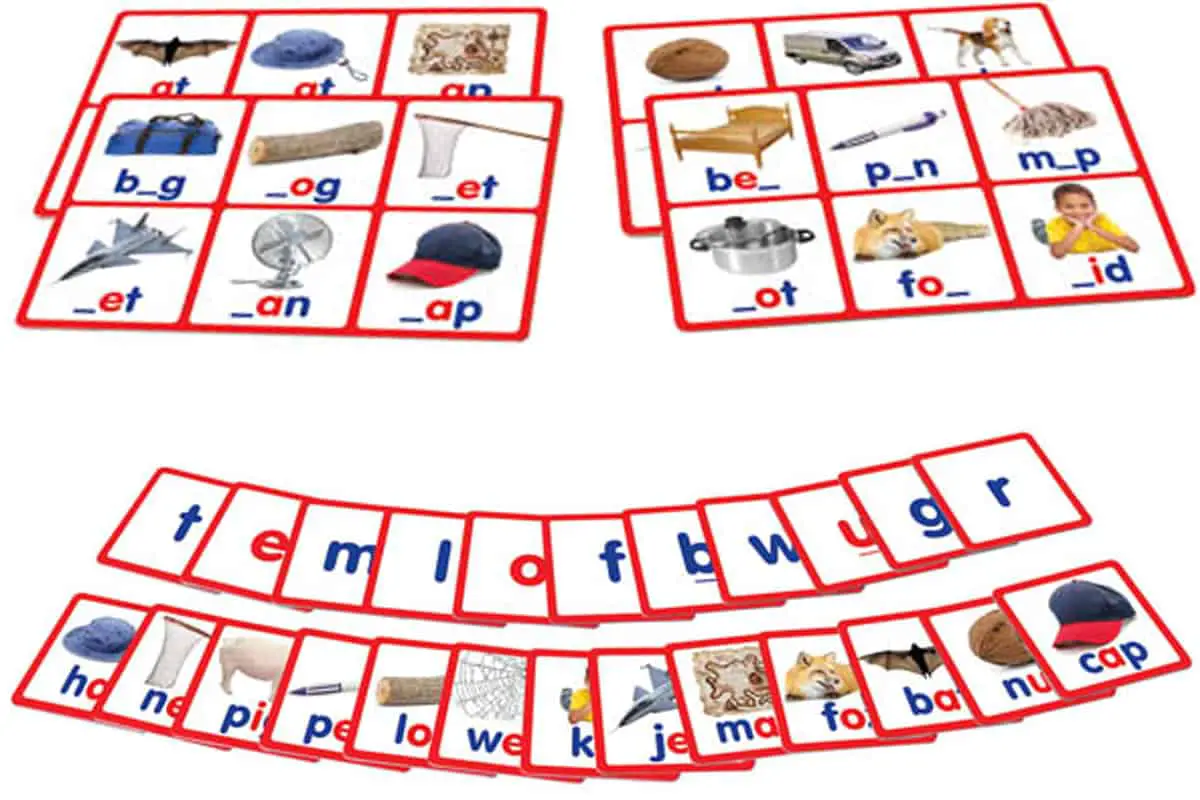
★★★★☆
For Families | Age 4-6 | 2-4 players | Price $$ | Duration 10-20 min
CVC Bingo is a bingo-inspired card game that aims to teach phoneme isolation and spelling. Each set has four boards and 24 letter cards.
is a bingo-inspired card game that aims to teach phoneme isolation and spelling. Each set has four boards and 24 letter cards.
Like Bingo, this game is played with a caller to call out the letters. Then, players check their cards to see if they have a matching missing letter. The first player to fully cover their board wins the game. I like this game because:
- It is easy and enjoyable to play
- The letters are color-coded – red for vowels and blue for consonants
- It teaches both reading and spelling skills
This game is an excellent addition for practicing phoneme isolation at home. But it can also be used for literacy centers in your classroom. However, this is a four-star game because there are only four boards, so this game has low replayability.
Big Box of Little Word Puzzles (Key Education)
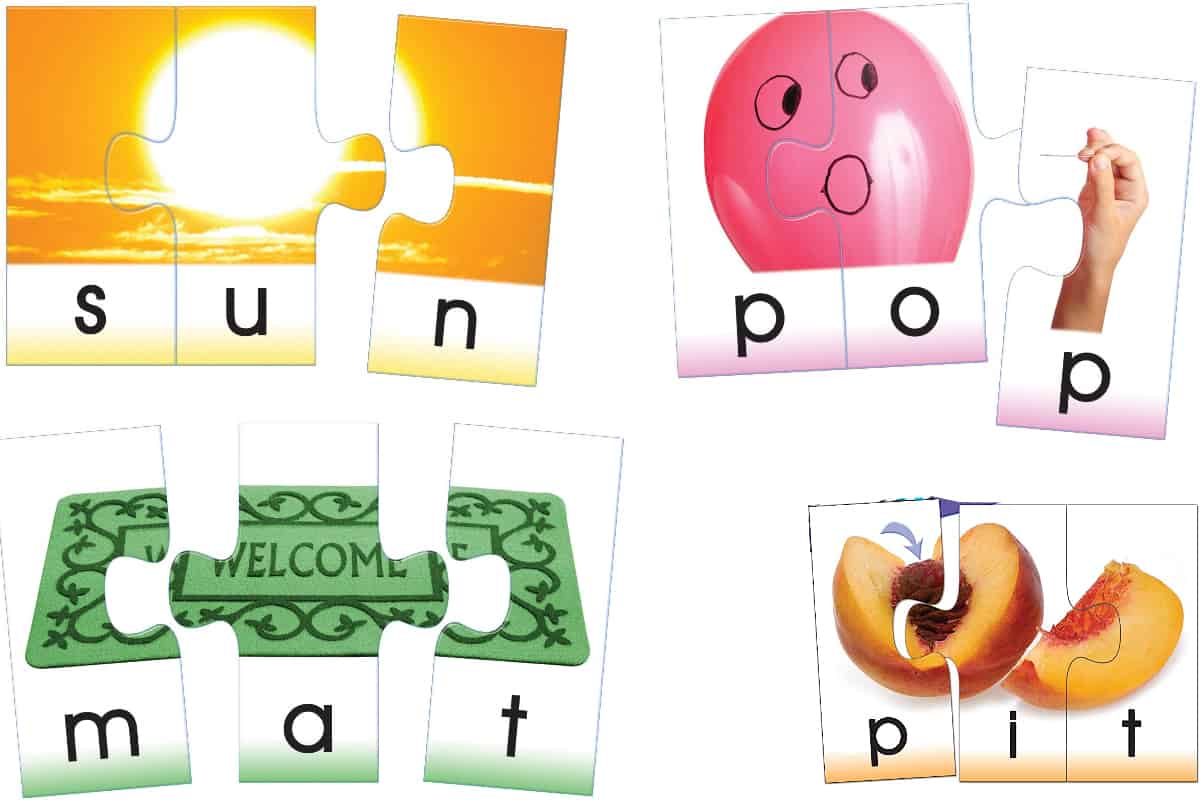
★★★★★
For Families and Schools | Age 4-6 | 1+ players | Price $$$ | Duration 10-20 min
Key Education’s Big Box of Little Word Puzzles is an excellent tool for teaching CVC words at home or in the classroom. Each set comes with 60 three-piece puzzles with actual photos of the objects.
is an excellent tool for teaching CVC words at home or in the classroom. Each set comes with 60 three-piece puzzles with actual photos of the objects.
This set can be used in four different ways, varying from competitive play to independent learning. These methods include:
- Reading practice – begin with one short vowel group at a time. Then, introduce the other short vowel puzzles as your beginning reader becomes more comfortable with blending. This can also
- Word scramble – scatter the puzzle pieces on a table, then have your child put them together and read the word. Your child can play on their own because they can rely on the picture to check if they have made a correct match
- Puzzle races – divide the words into how many students play, then put them in separate containers. Distribute these to the players to start the game. The first to complete all their puzzles wins!
- Memory game – Start with a few word puzzles, then separate them into beginning, middle, and ending sound piles. Next, have your child pick one puzzle from each group and make a word. This game is suitable for introducing blending and spelling CVC words.
I like this game because it can be played in different ways, depending on your child’s reading capability. It is also self-correcting, which is great for independent learning at home or in learning centers in the classroom. The puzzle pieces are also big, so younger players can easily handle them.
CVC SuperDeck Card Game (Strong Learning)
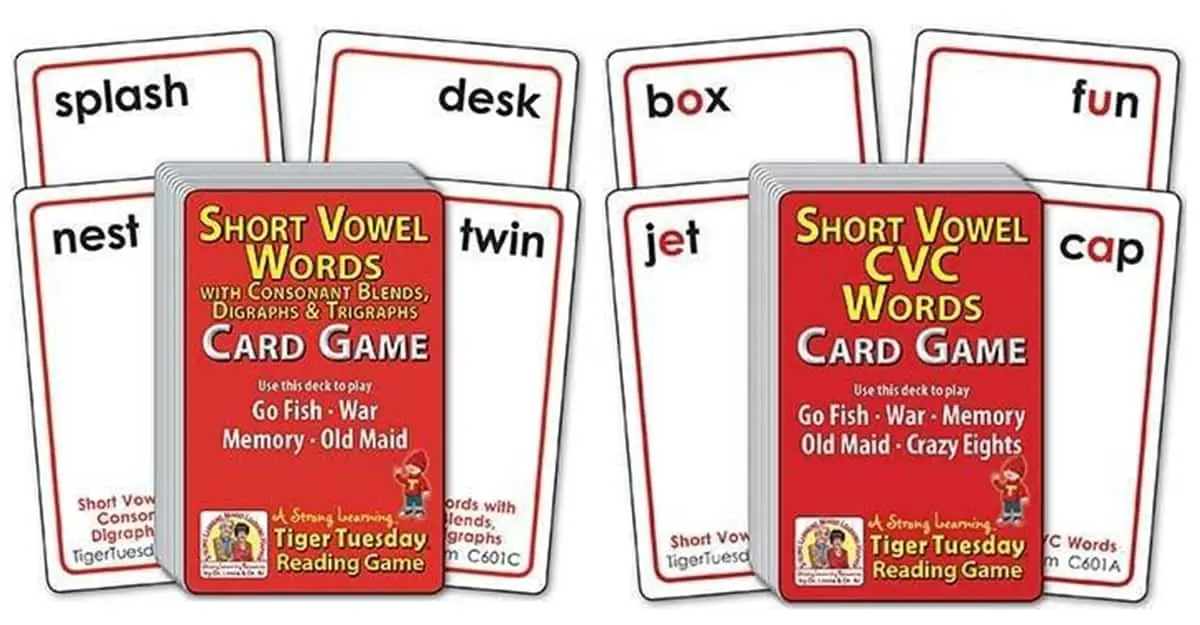
★★★★★
For Families and Schools | Age 4-6 | 1+ players | Price $$ | Duration 10-20 min
CVC SuperDeck Card Game features a set of 51 cards – 46 playing and 5 non-playing cards. You can use this set to play over 10 different card games, including:
features a set of 51 cards – 46 playing and 5 non-playing cards. You can use this set to play over 10 different card games, including:
- Go Fish
- Memory
- Reading Race
- Bingo
- Lotto
- War
I like this deck because it is easy to use and offers a lot of different game choices. The CVC words are also color-coded – black consonant and red vowels. So children can easily distinguish the letters. The cards can also be used in independent or competitive play, so players also develop their communication skills.
CVC Words Fluency SuperDeck Card Game (Strong Learning)
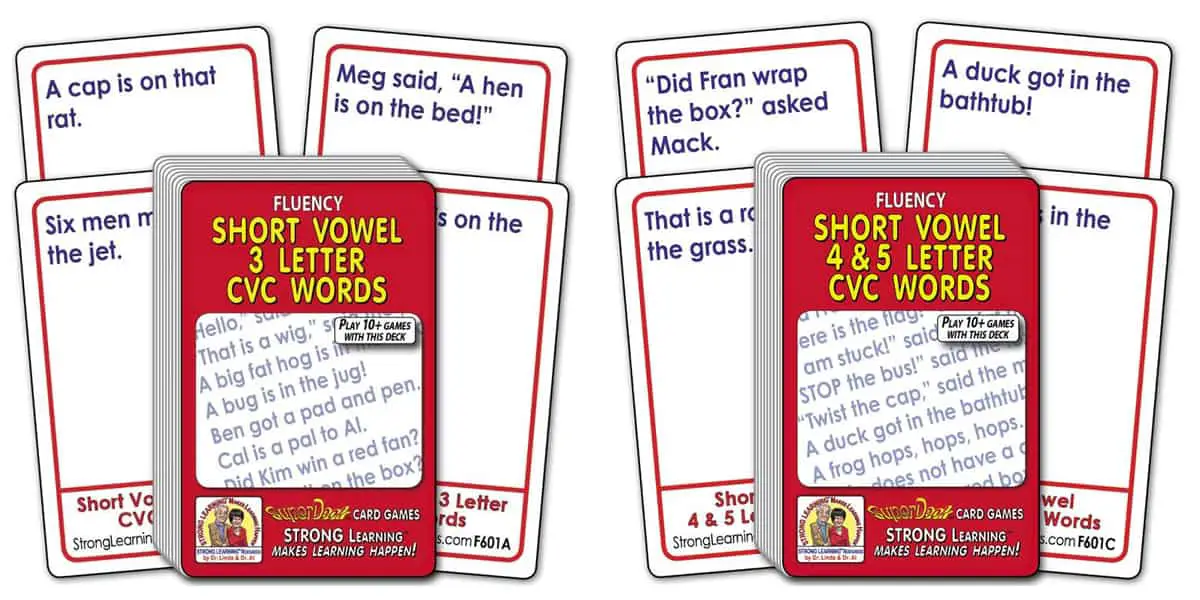
★★★★★
For Families and Schools | Age 5-7 | 1+ players | Price $$ | Duration 10-20 min
If you want a card game that teaches reading fluency in a fun way, then the CVC Words Fluency SuperDeck Card Game is a must-add to your collection. Like the previous game in this list, this set comes with standard size cards – 48 playing cards and 5 non-playing cards. It can also be used to play over 10 different games like Memory, Old Maid, and Go Fish.
is a must-add to your collection. Like the previous game in this list, this set comes with standard size cards – 48 playing cards and 5 non-playing cards. It can also be used to play over 10 different games like Memory, Old Maid, and Go Fish.
I like this set because:
- It introduces fun into reading practice
- It can be played independently or competitively
- It also includes age-appropriate sight words to enhance your child’s reading skills
- It lets your child work on their communication skills when playing with others
You can also use this set to teach your child how to write sentences because it shows common rules like capitalization and punctuation.
CVC Flash Cards
Phonics Flash Cards (Little Champion Reader)
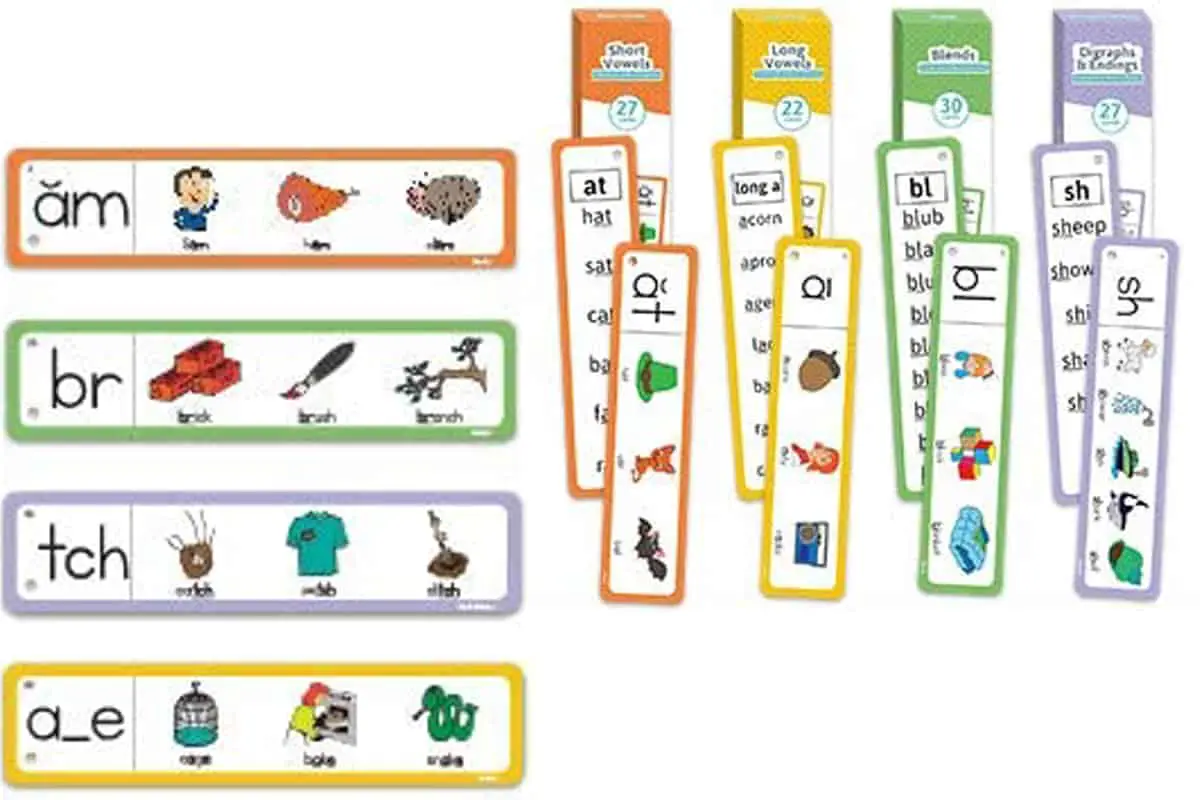
★★★★★
For Families and Schools | Age 4-8 | 1+ players | Price $$$ | Duration 10-20 min
Phonics Flash Cards features over 900 phonetic words that include:
features over 900 phonetic words that include:
- 27 Short vowels (mostly CVC words except for -ock and -oss)
- 30 Consonant blends
- 27 Digraphs and ending words
- 22 Long vowels
This set of flashcards covers the different phonetic patterns that beginning readers have to master. It starts with CVCs, followed by consonant blends, long vowels, and digraphs. And I like this because:
- You have most of what you will need to help your beginning reader transition into an emergent reader
- There is also a card with a list of words for a specific word pattern and a matching card with pictures of some of the words for younger learners
- The cards are color-coded for easy storage
Each box also comes with 4 rings so you can stack the patterns together.
Decoding Flashcards (Junior Learning)
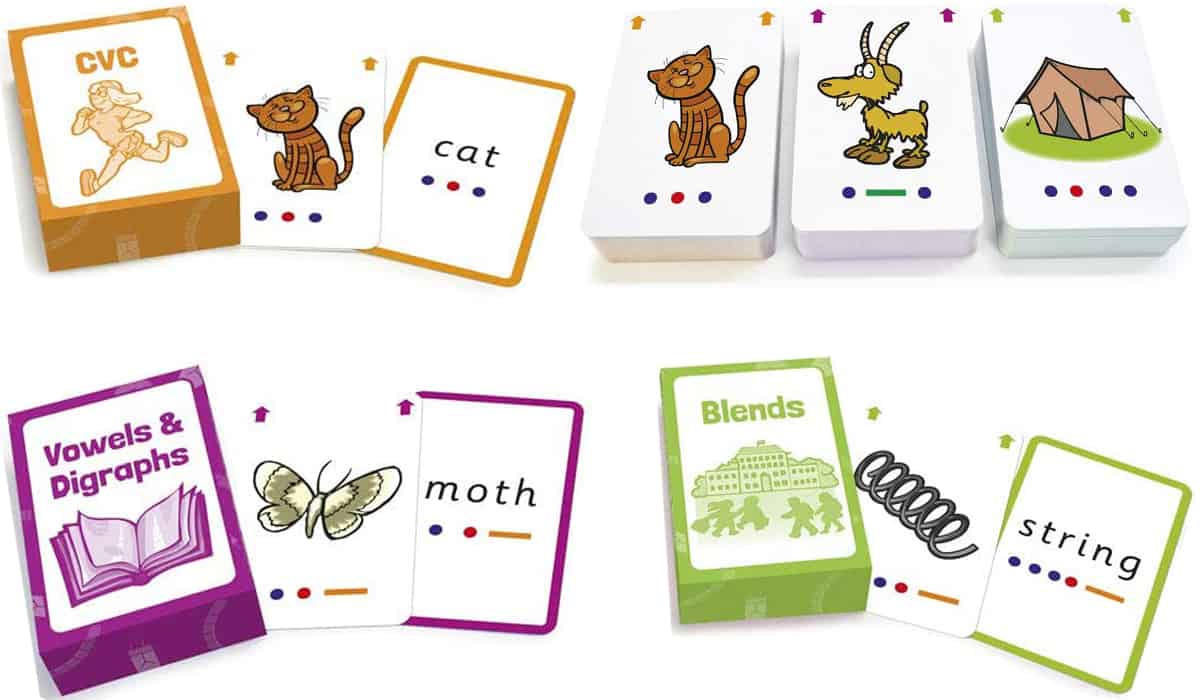
For Families and Schools | Age 4-8 | 1+ players | Price $$ | Duration 10-20 min
Junior Learning’s Decoding Flashcards features 3 decks of 54 color-coded cards covering CVCs, long vowels and digraphs, and blends. You can also get the Flashbot
features 3 decks of 54 color-coded cards covering CVCs, long vowels and digraphs, and blends. You can also get the Flashbot to add more fun while using them.
to add more fun while using them.
I like this set because:
- It covers several phonetic patterns to help your beginning reader
- It has sound buttons to help students identify the patterns, like blue dots for consonants and red dots for vowels
- The picture cards with sound buttons also help develop phonemic awareness
- The cards are also color-coded for easy organization
This set of flashcards can be a great addition to your beginning reader’s resources. However, the typeface used is not appropriate for all types of students. In addition, the added flourishes can be confusing for younger readers.
CVC Words Flash Cards (Shanni Griffi)
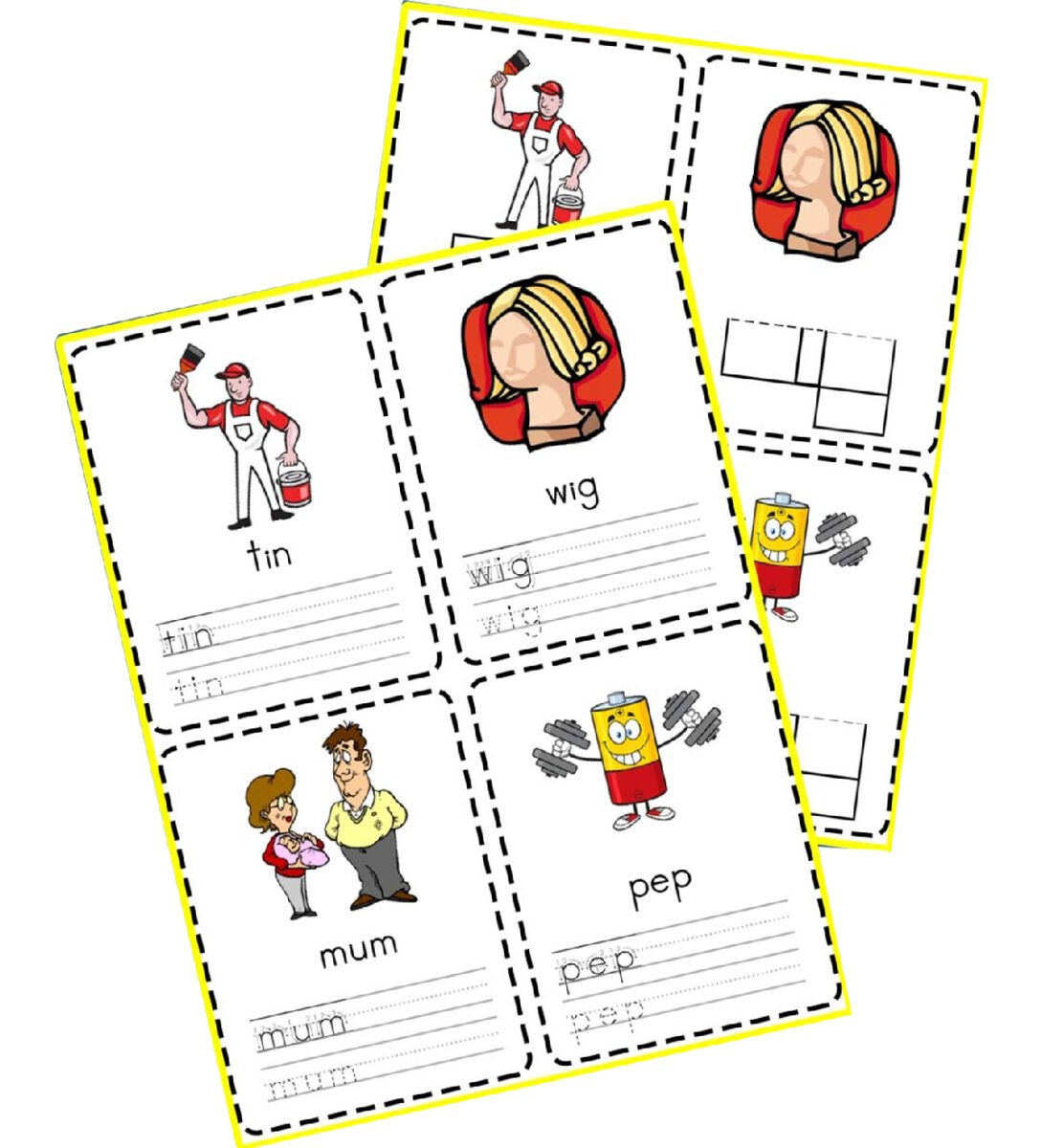
★★★☆☆
For Families and Schools | Age 4-6 | 1+ players | Price $$ | Duration 10-20 min
CVC Words Flash Cards is a set of 200 CVC words with pictures flashcards. It features common word families that can help your child develop their reading fluency.
is a set of 200 CVC words with pictures flashcards. It features common word families that can help your child develop their reading fluency.
This set of flashcards features Elkonin boxes and guidelines for writing. I like these flashcards because:
- It teaches letter writing as the letters have directions for younger children
- It has cards with the pictures only to help teach phonemic awareness
However, I am giving this set three stars because some pictures are hard to name for young readers. Although there is a matching card with the names, it is not practical, especially when there is no adult to supervise. I also don’t like that the Elkonin boxes follow the shape of the letters. It may have been better if the boxes are the same sizes.
Other Board and Card Games for Beginning Readers
Some students struggle with reading, so it is always great to add different ways to teach them without making it more challenging. That is why the board and card games are great additions to homes and classrooms. It introduces fun into the learning process, so children become more engaged in the task. And for beginning readers, here are some posts to guide you:
- 10 Rhyme Board Games and Toys for Preschoolers and Primary School

- 8 Rhyme Bingo Games for Schools and Families

- 13 Rhyme Card, Puzzle & Domino Games for Primary & Preschool Children

Edudingo.com is a participant in the Amazon Services LLC Associates Program, an affiliate advertising program designed to provide a means for sites to earn advertising fees by advertising and linking to Amazon.com. We also participate in other affiliate programs which compensate us for referring traffic.

